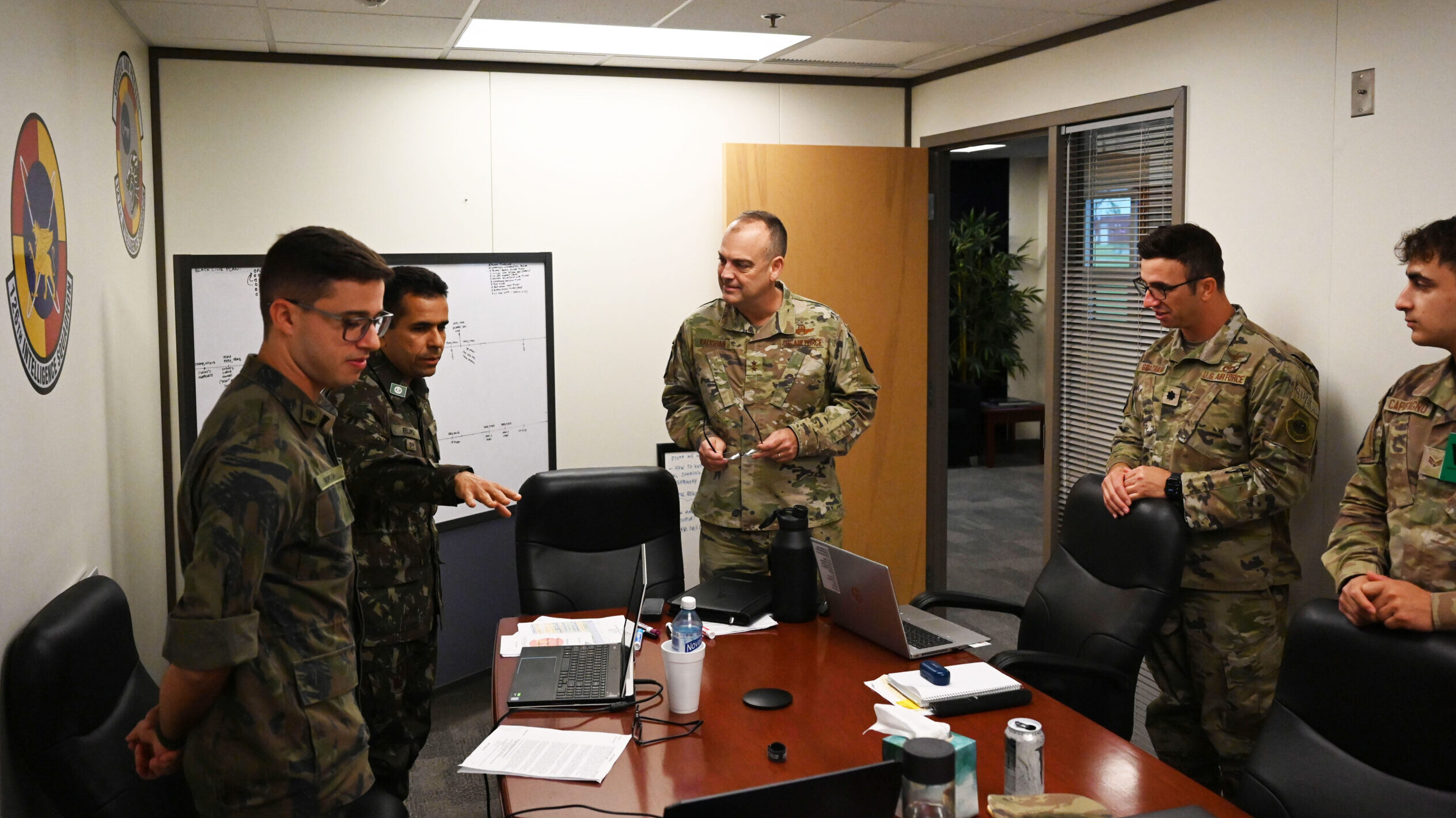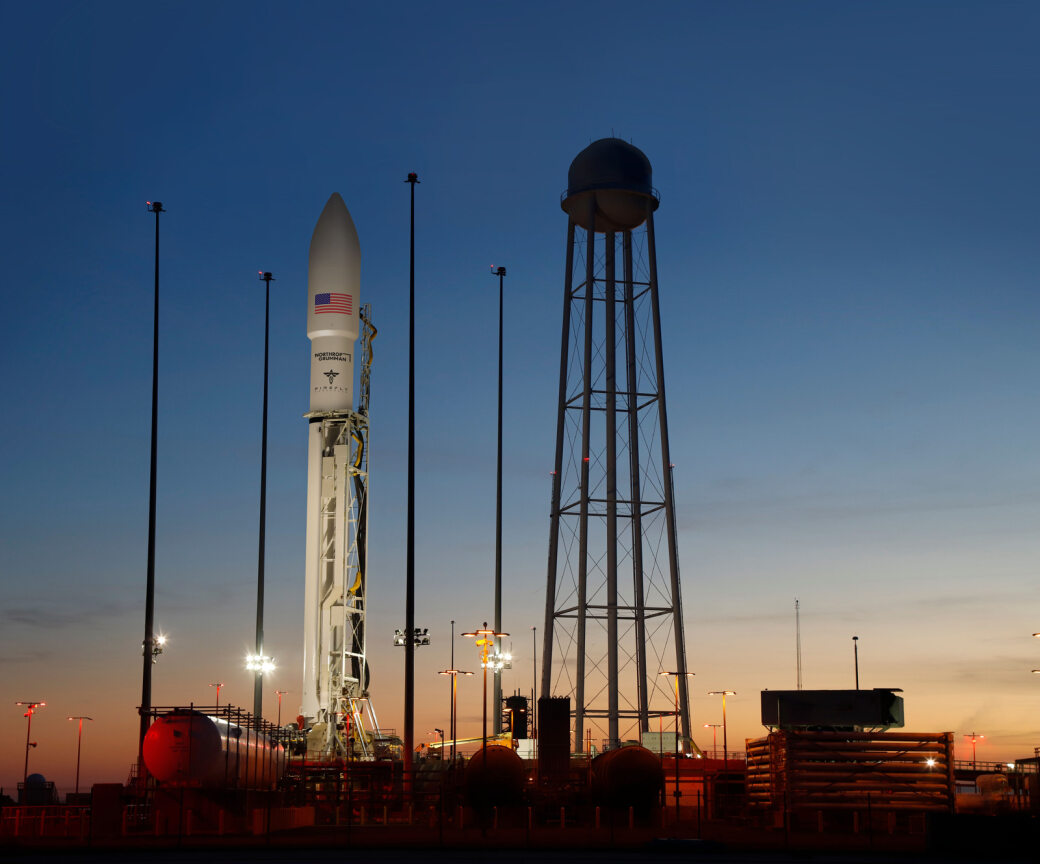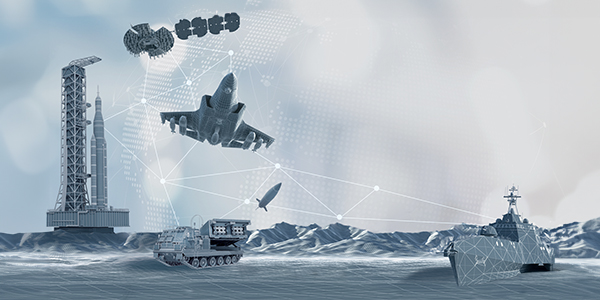
Air Force Maj. Gen. Edward Vaughan, director of space operations for the National Guard Bureau, introduces himself to members participating in the the Vulcan Guard Aug. 10, 2023 at the 178th Wing in Springfield, Ohio, including participants from the Brazilian military. (U.S. Air National Guard photo by Airman 1st Class Colin Simpson)
WASHINGTON — The longer the debate churns on over how to best align the roughly 1,200 personnel within the Air National Guard who now do space-related jobs with their active duty cohorts in the Space Force, the more erosion of service readiness is inevitable, according to the National Guard Bureau’s new top space officer.
“[T]he status quo is not going to be sustainable,” Director of Space Operations Maj. Gen. Edward Vaughan told Breaking Defense in an interview Aug. 18. Vaughan, whose call sign “Hertz” is a reflection of his career in electronic warfare, took over the position only two months ago.
The fate of the National Guard’s space professionals — who are organized into 14 units across seven states and make up 30 percent of the Space Force’s operational squadrons, as well as a whopping 60 percent of the service’s “offensive space electronic warfare capabilities” according to a Guard fact sheet [PDF] — has remained in limbo since the creation of the newest military service in 2019. Congress, the Biden administration and the Guard leadership have been bickering over whether those forces should stay attached to the Air Force, be assigned to a separate Space Guard component attached to the Space Force or rolled into a single “hybrid component” of full- and part-time Guardians.
The prevailing Guard position has been in favor of a Space National Guard; with advocates arguing that the average space operator within the Guard has about seven years of experience, vice the two- to three-years of the average active duty Guardian.
In an interview with Breaking Defense last month, Gen. Daniel Hokanson, the chief of the National Guard bureau, further stressed the value of Air National Guard space professionals to the Space Force because of their technical prowess and mission expertise.
“The difference between the Guard and the Reserve units in this case is ours are actually units. They have equipment, they have a mission, they go out and do a specific mission. And I can’t speak completely for the Reservists, but my understanding is many of them just they fill in gaps for the active units. And so when you look at that, we’re almost all tooth, and hardly any tail,” he said. “They’re deployed today doing missions. And they’re critically important to our combatant commanders.”
In contrast, the broader Defense Department has argued for the hybrid idea, based on White House calculations of a $500 million annual cost of a new organization.
And Congress, who will have the ultimate say, is divided, with the House calling for a Space Guard in its version of the fiscal 2024 National Defense Authorization Act (as well as in FY23) and the Senate instead ordering a study of the three options by a federally funded research and development center.
Diverging Processes
While that debate rages on and time goes by, Vaughan said, the problem is that “as the Space Force really starts to find its own identity” its processes are diverging from the Air Force.
Specifically, Vaughan elaborated, the newest service increasingly “has its own culture, it has its own training and has its own specialty codes [identifying different jobs and how personnel qualify to do them]. It has its own way to do budgeting and resourcing. The equipment, purchasing the upgrades, the modernization all on a Space Force battle rhythm. And they’re very much in a Space Force mission set. And so with our units being resourced by the Air Force, there’s a bit of a disconnect.”
Another growing issue is the widening gap between how the Air Force and the Space Force “present forces for deployment,” Vaughan said. Each military service has its own “force generation model,” he said, “how those services organize, train, equip, and present forces to the combatant command.” That model also is “the way they report readiness to the DoD, and then that informs their requirements to get resources. It’s all connected, and part of the presidential budgeting process.”
The two service’s force generation models, he said, “are different, and they’re becoming more different. And there’s good reason they should be different. The way you the way you achieve space victory, and space effects, and space superiority is very different.”
Which already has presented problems for the National Guard space operators, since they are required to report (and get resourced) through the Air Force model, but work when they are “deployed and employed” under the Space Force model.
Even how to report on readiness has become a conundrum because of this difference, since each service does it in different ways through different computer systems, Vaughan said.
“The question is which system do we put all the data in?,” he said, adding that in some cases up to now the decision has been to report via both systems — causing both a resource drain and oversight issues since the Pentagon then has to untangle what is going on.
And the worry is that these disconnects can only grow as time goes own.
“The Secretary of the Air Force has and will continue to to keep it whole while this decisions being made. And we really appreciate Secretary the Air Force’s leadership in that respect, but I think all parties are in agreement that we got to move forward,” Vaughan said.
Keepin’ On Keepin’ On — Supporting Combatant Commands, Sharing With Allies, Innovating
Through it all, Air National Guard space forces are getting on with their day-to-day work.
For example, the Ohio Air National Guard’s 178th Wing on Aug. 10-11 hosted the annual Vulcan Guard space exercise, that this year included personnel from US Space Command, the Brazilian military and all seven National Guard states conducting space operations. Vaughn said this is the second time Brazil, which participates in the National Guard’s State Partnership Program, has appeared in the Vulcan Guard series, having done so two years ago. Last year, Poland was the overseas partner in the exercise.
Another critical part of the Air National Guard’s space job, he said, is serving as innovation arm by bringing new commercial technologies and capabilities into the Space Force’s tool kit via the small pot of National Guard Reserve Equipment Account funds — with the Vulcan Guard exercises serving as a platform for testing them out.
“On a very shoestring budget, our folks have developed a list of capabilities in two primary areas. One is in space situational awareness,” Vaughan said — with the ability to detect and track objects in space both a top concern for SPACECOM and an area whether the command and the Space Force are trying to beef up ties with allies and partner nations to improve mutual capabilities.
“And in some cases, what they’ve done is they’ve just gone to Space Systems Command, or they’ve gone to SPACECOM, and tagged on a capability to an existing capability, kind of enhanced it. In other cases, we’ve done something completely different. And in almost all these are much lower levels of classification, much lower cost, and so they become natural capabilities that you can share with allies or partners,” he said.
Indeed, Vaughan noted that during a recent visit to the National Guard 114 Space Control Squadron at Cape Canaveral, responsible for electronic warfare operations, US Central Command head Gen. Michael Kurilla asked that the squadron bring over some of its unclassified EW capabilities to his command to share with allies and partners in the region.
“So that’s what we’re working through now with Space Command was Space Force and with CENTCOM,” he said.












